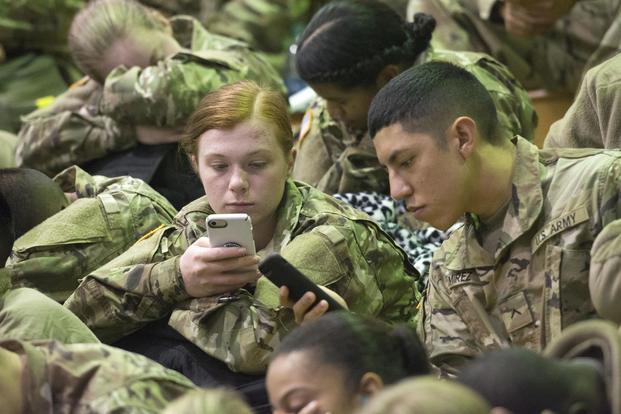Defense Secretary Jim Mattis said Thursday that a possible ban on cellphone use at the Pentagon by uniformed and civilian personnel could be extended to other bases and facilities.
"We're not talking just the Pentagon," but "this is the headquarters for our far-flung U.S. military," Mattis said before a closed meeting with British Secretary of State for Defense Gavin Williamson.
"So we're looking at how we maintain electronic security" and how personal devices such as cellphones and exercise trackers are used by personnel worldwide, Mattis said.
Earlier, Dana White, the chief Pentagon spokesperson, said that of the potential ban that "It's not just about this building, I want to be clear about that, it's not just about the Pentagon."
She said that a ban was among the considerations of a review Mattis has ordered up that was accelerated by disclosures last weekend that the locations and activities of troops could be gleaned from their personal devices.
"He's thinking about the totality of the DoD enterprise" worldwide with the aim of protecting service members and the civilian workforce from being targeted by information downloaded from cellphones or exercise trackers.
White also made clear that, for Mattis, security would trump the concerns of the workforce on how any potential ban on personal devices would be implemented.
"Operational security is his priority," White said of Mattis' response to the weekend reports that an interactive map found online -- the Global Heat Map, published by the GPS tracking company Strava -- used satellite information to map the locations and movements of exercise trackers such as Fitbit and Jawbone.
"It's about electronics, GPS-enabled electronics. You have to also consider the fact that we have been attacked, bases have been attacked," she said. "Information is power and our adversaries have used information to plan attacks against us."
"Of course, he will also consider the concerns of the workforce" in possibly enacting a drastic measure such as a cellphone ban in the Pentagon, where more than 22,000 uniformed and civilian personnel report for work daily, White said at a Pentagon briefing.
However, she did not respond directly to basic questions raised by the possibility of a cellphone ban at the Pentagon or elsewhere.
For instance, what would happen when a school or hospital is trying to reach uniformed or civilian personnel to say that a child is sick or hurt? Where and how would they store cellphones if they could not bring them into the building or onto the base? How could they gain quick access in an emergency?
With respect to the workforce, White said, "the Secretary's primary interest is to insure that we are all safe and that we are all secure." She said the disclosures about the exercise trackers "have allowed him [Mattis] to take a bigger look at what are we doing and how are we doing it."
"So all of those things will be considered in his calculus, but you have to understand that the Secretary sees everything within that prism -- of how do I protect the civilians, the service members, their families. So that's how he will make his decision," White said, but she gave no timeline on when the review might be completed.
The problems for the military posed by the exercise trackers have raised concerns among the Joint Chiefs that go well beyond the use of personal devices.
Air Force Gen. Paul Selva, the vice chairman of the Joint Chiefs of Staff, said Tuesday at a breakfast with defense reporters that the main question was how DoD was going to deal with data that could end up in the hands of enemies.
He asked: "What are you going to do when the enemy can know everything about you simply because they can exploit big data?"
"The motive wasn't evil," Selva said, when Strava put out the Global Heat Map. "What Strava was trying to do was inform people who are athletically inclined on the repetitiveness and utility of their exercise," he said.
The side effect, he said, was that anyone looking at the map could get accurate GPS locations as well as the metadata that exists on tracking devices which "gives a lot of information."
As an example, Selva cited the highly-restricted Pacific island of Diego Garcia, a base for long-range bombers.
"The map of Diego Garcia is shaped like your right foot. What you saw from the running patterns {off the exercise trackers] is exactly what I experienced when I was deployed there five times between 1985 and 1999," Selva said.
"Those of you who are physically active will run the six miles from downtown to the airfield," Selva said, and "what you get is a very accurate map of the western edge of Diego Garcia" from the data off the trackers, he said.
Although there are questions now about the use by troops of exercise trackers, the military has been promoting them for several years.
In 2013, the Army began a pilot fitness program with the issuance of Fitbit Flex wrist bands to soldiers to help them get in shape.
Called the "Performance Triad," the program focused on good nutrition, activity levels and getting enough sleep. Army officials said the pilot program involved about 2,200 soldiers at Joint Base Lewis-McChord, Washington, Fort Bragg, North Carolina and Fort Bliss, Texas.
"This is not about dieting," then-Army Surgeon General Lt. Gen. Patricia Horoho said at the time. "This is looking at improving their performance to be a better soldier, to be a better spouse, to be a better person."
In 2015, the Army broadened the initial pilot program to involve about 20,000 soldiers.
Oriana Pawlyk contributed to this report.
-- Amy Bushatz can be reached at amy.bushatz@military.com.
-- Richard Sisk can be reached at Richard.Sisk@Military.com.













